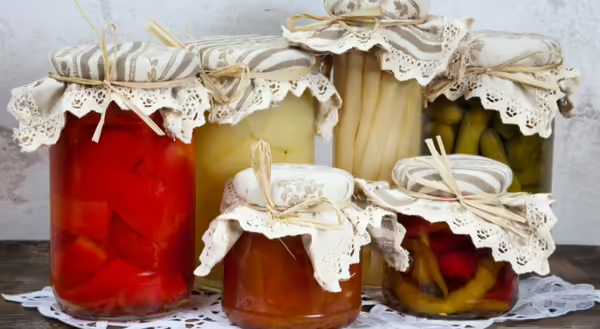
Canning season is upon us! While many are busy planting their summer gardens, others are already preparing to harvest spring vegetables, herbs, and berries. Canning is a great way to use the foods you have grown in your garden or have purchased from your local farmer’s market. Moreover, canning allows you to enjoy the wonderful tastes of summer all year long while keeping food safely preserved on your shelf.
There are two methods of canning, boiling water bath canning and pressure canning. The acidity of the food will determine the processing method.
The boiling-water canning method is used for acidic foods, meaning those having a pH value of 4.6 or less. Most fruits are naturally high in acid and thus are safe to process using this method. However, some foods must have additional acid add because they lack the level of acid needed to prevent spoilage. These foods include pickled foods, tomato products, and figs which have a pH value right around 4.6.
A water bath canner will reach a temperature of 212 °F at sea level, which is high enough to destroy molds, yeasts, and most harmful bacteria. However, it will not reach a high enough temperature to destroy the dangerous toxins created by the bacteria Clostridium botulinum (C. botulinum).
Why do Low Acid Foods Need to be Processed Using a Pressure Canner?
Great question! It was once thought the longer you cooked canned goods, the safer the food. However, advances in science have proven this not to be true. This is because harmful microorganisms, such as C. Botulinum, produce harmful toxins when improperly canned, leading to botulism.
C. botulinum is a tough germ that wants to stick around no matter how long you process it in a water bath canner. Therefore, the only way to destroy it and safely process low-acid foods is to use a pressure canner.
Low acid foods must be heated to a temperature of 240 °F and held there for a specified amount of time. Only a pressure canner is able to achieve this intense temperature required to ensure your food will be processed safely when canning at home. The amount of time food will need to be processed will depend on the type of food and the recipe being used. It is the combination of high temperature and prolonged processing time that destroy the bacteria and toxic bacterial spores produced by C. botulinum.
What are Low Acidic Foods
Low acid foods have a pH value greater than 4.6. These include foods such as asparagus, carrots, green beans, potatoes, peas, meats, fish, cabbage, beets, corn, and kidney beans just to name a few. Check out this detailed list of low acidic foods.
Source: Diane Reinhold, MPH, MS, RDN is a University of Illinois Extension, Educator, Nutrition and Wellness, serving Jo Daviess, Stephenson & Winnebago Counties.
References:
- Home Canning and Botulism. (2018, June 11). Retrieved May 14, 2020.
- How Do I? ...Can. (n.d.). Retrieved May 14, 2020.